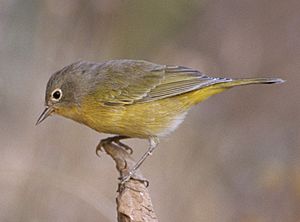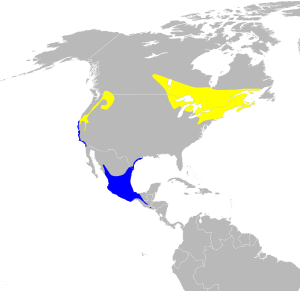Nashville warbler facts for kids
Quick facts for kids Nashville warbler |
|
|---|---|
 |
|
| In Winema National Forest, Oregon | |
| Conservation status | |
| Scientific classification | |
| Genus: |
Leiothlypis
|
| Species: |
ruficapilla
|
 |
|
| Breeding range
Winter range |
|
| Synonyms | |
|
Sylvia ruficapilla Wilson, 1811 |
|
The Nashville warbler (Leiothlypis ruficapilla) is a small, colorful songbird. It belongs to the New World warbler family. You can find these birds in North and Central America. They spend their summers, or breed, in parts of the northern and western United States and southern Canada. When winter comes, they fly south to warmer places. These include southern California, Texas, Mexico, and the northern parts of Central America. Nashville warblers have a gray head and a green back. Their belly is white, and their throat and chest are bright yellow.
Contents
What Does a Nashville Warbler Look Like?
The Nashville warbler is a small bird. Both male and female warblers have a gray head that blends into a greenish back and wings. Their belly is white, and their throat and chest are yellow. They have a clear white ring around each eye. They do not have any special markings on their wings. Their beak is thin, pointed, and black.
Adult male Nashville warblers have a rusty brown patch on the top of their head. This patch is usually hard to see because gray feathers cover it. However, males might show it more if they are upset or excited. Female and young birds have a duller, more olive-gray head. Their yellow throat and chest colors are also not as bright.
Nashville warblers are related to other warblers. These include Virginia's warbler, Lucy's warbler, and the Colima warbler. All four of these birds look quite similar.
Size of a Nashville Warbler
Here are some typical measurements for a Nashville warbler:
- Length: 4.3 to 5.1 inches (11 to 13 cm)
- Weight: 0.2 to 0.5 ounces (6.7 to 13.9 grams)
- Wingspan: 6.7 to 7.9 inches (17 to 20 cm)
Nashville Warbler Sounds
The song of the Nashville warbler sounds like a quick seewit-seewit-seewit-ti-ti-ti. Male birds sing their songs from open branches in their nesting areas. Their call sounds like a high seet. Warblers living in the western parts of North America have a slightly deeper and richer song. Their call note is also sharper.
Where Do Nashville Warblers Live?
Nashville warblers breed in two different areas. One area is in Canada and the northeastern United States. The other is in the western United States. In eastern Canada, their breeding range goes from Côte-Nord to Cape Breton Island. It also stretches across central Alberta. They mostly breed between about 52 and 45.5 degrees north latitude. You can also find them, though less often, in the Appalachian Mountains of Pennsylvania and West Virginia.
Even though they are named after Nashville, Tennessee, these warblers only visit that city when they are migrating. They fly south for the winter. Their winter homes include the southernmost parts of Texas and California. They also spend winter in central Mexico and the northern parts of Central America. This includes countries like Guatemala and El Salvador.
When they are breeding, Nashville warblers like to live in open forests. These forests often have a mix of different tree types. They also like bog habitats, which are wet, marshy areas.
Nashville Warbler Behavior
Nashville warblers find their food by gleaning. This means they pick insects off the lower branches of trees and shrubs. They often flick their tails while they are looking for food. In winter, these birds gather into loose groups. Sometimes, they even join groups of different bird species to feed together. Nashville warblers mostly eat insects. But in winter, they also eat berries and nectar from flowers.
Reproduction and Life Cycle
Nashville warblers hide their nests on the ground. They usually place them under shrubs to keep them safe. The nests are shaped like open cups. They build them using strips of bark, leaves, and moss. They line the inside with soft materials like feathers or animal hairs.
A female warbler usually lays four or five eggs at a time. This group of eggs is called a clutch. The eggs hatch after about 11 to 12 days. Only the female bird sits on the eggs to keep them warm, which is called incubating. The male bird brings her food while she is on the nest.
When the young birds hatch, they do not have many feathers. They only have some soft brown down. Their eyes are also closed. The young birds stay in the nest for about 11 days. After that, they are ready to leave the nest and fly, which is called fledging.
Images for kids
See also
 In Spanish: Reinita de Nashville para niños
In Spanish: Reinita de Nashville para niños




